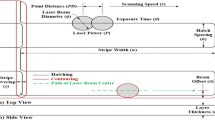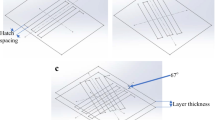Abstract
In this study, one-dimensional beads and three-dimensional cubes of 1.2709 maraging steel were printed using a laser additive manufacturing (AM) technology. The direct energy deposition (DED) was firstly employed to evaluate the optimal conditions of the single-bead deposition. High-energy (> 64.9 J/mm2) and low-energy (< 64.9 J/mm2) groups of beads were deposited according to a full factorial design of experiment (DOE) and analyzed regarding the optimal aspect ratio between 3 and 5. The low-energy DED was evaluated as the optimal one regarding the required morphology with large process window. The effect of DED process parameters on density/porosity, microstructure, and residual stresses of the cubic specimens was then analyzed. It was found that by reducing the laser energy and print overlap, it is possible to drastically reduce the residual stresses as well as by increasing the powder density. Scanning strategies do not have a strong influence on residual stresses but affect the porosity. Moreover, the porosity is increased with increasing laser energy and print overlap. The best compromise between porosity, residual stresses, and productivity was obtained with a surface energy of 35 J/mm2, a 30% overlap, and a bidirectional-rotation scanning strategy. The presented work highlights the essential experimental data for an upcoming DED of large parts and their characterization suitable for industrial injection molding applications.













Similar content being viewed by others
Data availability
The authors confirm that the data supporting the findings of this study are openly available and transparent.
Code availability
Not applicable.
References
Hu Y, Lin X, Li Y, Ou Y, Gao X, Zhang Q, Li W, Huang W (2021) Microstructural evolution and anisotropic mechanical properties of Inconel 625 superalloy fabricated by directed energy deposition. J Alloys Compd 870:159426. https://doi.org/10.1016/j.jallcom.2021.159426
Bailey NS, Katinas C, Shin YC (2017) Laser direct deposition of AISI H13 tool steel powder with numerical modeling of solid phase transformation, hardness, and residual stresses. J Mater Process Technol 247:223–233. https://doi.org/10.1016/j.jmatprotec.2017.04.020
Yadav S, Paul CP, Jinoop AN, Rai AK, Bindra KS (2020) Laser directed energy deposition based additive manufacturing of copper: process development and material characterizations. J Manuf Process 58:984–997. https://doi.org/10.1016/j.jmapro.2020.09.008
Shrestha S, Panakarajupally RP, Kannan M, Morscher G, Gyekenyesi AL, Scott-Emuakpor OE (2020) Analysis of microstructure and mechanical properties of additive repaired Ti–6Al–4V by direct energy deposition. Mater Sci Eng A 806:140604. https://doi.org/10.1016/j.msea.2020.140604
Xie J, Lu H, Lu J, Song X, Wu S, Lei J (2021) Additive manufacturing of tungsten using directed energy deposition for potential nuclear fusion application. Surf Coat Technol 409:126884. https://doi.org/10.1016/j.surfcoat.2021.126884
Koike R, Misawa T, Aoyoama T, Kondo M (2018) Controlling metal structure with remelting process in direct energy deposition of Inconel 625. CIRP Ann Manuf Technol 67:237–240. https://doi.org/10.1016/j.cirp.2018.04.061
Ben-Artzy A, Reichardt A, Borgonia JP, Dillon RP, McEnerney B, Shapiro AA, Hosemann P (2021) Compositionally graded SS316 to C300 Maraging steel using additive manufacturing. Mater Des 201:109500. https://doi.org/10.1016/j.matdes.2021.109500
Shinde MS, Ashtankar KM (2017) Additive manufacturing–assisted conformal cooling channels in mold manufacturing processes. Adv Mech Eng 9(5):168781401769976. https://doi.org/10.1177/1687814017699764
Young S (2016) Additive manufacturing applications for the tooling industry: custom conformal cooling for injection molding. Bastech, Inc
Piekło J, Garbacz-Klempka A (2020) Use of maraging steel 1.2709 for implementing parts of pressure mold devices with conformal cooling system. Materials 13:5533. https://doi.org/10.3390/ma13235533
Marques S et al (2014) Evaluating the conformal cooling system in moulds for plastic injection by CAE simulation. ICIT&MPT Conference Proceedings, Slovenia
Santos LMS, Ferreira JAM, Jesus JS, Costa JM, Capela C (2016) Fatigue behaviour of selective laser melting steel components. Theor Appl Fract Mech 85(Part A):9–15. https://doi.org/10.1016/j.tafmec.2016.08.011
Meneghetti G, Rigon D, Cozzi D, Waldhauser W, Dabalà M (2017) Influence of build orientation on static and axial fatigue properties of maraging steel specimens produced by additive manufacturing. 3rd International Symposium on Fatigue Design and Material Defects. https://doi.org/10.1016/j.prostr.2017.11.072
Casati R, Lemke JN, Tuissi A, Vedani M (2016) Aging behaviour and mechanical performance of 18-Ni 300 steel processed by selective laser melting. Metals 6. https://doi.org/10.3390/met6090218
Perkas M (1970) The structure and properties of high-strength maraging steels. Metalloved Term Obrab Met No 7:12–25
Bai Y, Wang D, Yang Y and Wang H (2019) Effect of heat treatment on the microstructure and mechanical properties of maraging steel by selective laser melting. Mater Sci Eng A, 760, 105-117, doi: https://doi.org/10.1016/j.msea.2019.05.115
Wei D, Qian B and Bi Z (2018) Machining characteristics of 18Ni-300 steel in additive/subtractive hybrid manufacturing. Int J Adv Manuf Technol 95, 2509–2519, doi: https://doi.org/10.1007/s00170-017-1364-0.
Kirchheim A, Katrodiya Y, Zumofen L, Ehrig F, Wick C (2021) Dynamic conformal cooling improves injection molding. Int J Adv Manuf Technol 114:107–116. https://doi.org/10.1007/s00170-021-06794-0
Chen B, Huang Y, Gu T, Tan C (2018) Investigation on the process and microstructure evolution during direct laser metal deposition of 18Ni300. Rapid Prot. Journ., Emerald publ. https://doi.org/10.1108/RPJ-01-2018-0022
Campanelli S et al (2015) Free-form fabrication of steel parts by multi-layer laser cladding. Proceedings Lasers in Manuf. Conf., Germany
Jägle E, Sheng Z, Kürnsteiner P, Ocylok S, Weisheit A, Raabe D (2016) Comparison of maraging steel micro- and nanostructure produced conventionally and by laser additive manufacturing. Materials:10. https://doi.org/10.3390/ma10010008
Karg M et al (2016) Comparison of process characteristics and resulting microstructures of maraging steel 1.2709 in additive manufacturing via laser metal deposition and laser beam melting in powder bed. Conference: Conference: 6th International Conference on Additive Technologies, Germany
Kürnsteiner P, Wilms MB, Weisheit A, Barriobero-Vila P, Jägle EA, Raabe D (2017) Massive nanoprecipitation in an Fe-19Ni-xAl maraging steel triggered by the intrinsic heat treatment during laser metal deposition. Acta Mater 129:52–60. https://doi.org/10.1016/j.actamat.2017.02.069
Yao Y, Huang Y, Chen B, Tan C, Su Y, Feng J (2018) Influence of processing parameters and heat treatment on the mechanical properties of 18Ni300 manufactured by laser based directed energy deposition. Opt Laser Technol 105:171–179. https://doi.org/10.1016/j.optlastec.2018.03.011
Mugwagwa L, Yadroitsev I, Matope S (2019) Investigation and management of residual stresses in selective laser melting of maraging steel. Metals 2019(9):1042. https://doi.org/10.3390/met9101042
Manjaiah M, Hascoët JY, Rauch M (2020) Effect of process parameters on track geometry, microstructural evolution on 316L stainless steel multi-layer clads. Mater Sci Eng B 259:114583. https://doi.org/10.1016/j.mseb.2020.114583
Goodarzi DM (2017) Analysis of laser cladding process parameter influence on the clad bead geometry. Welding in The World 61(5):883–891. https://doi.org/10.1007/s40194-017-0495-0
Mercelis P, Kruth J (2006) Residual stresses in selective laser sintering and selective laser melting. Rapid Prototyp J 12(5):254–226. https://doi.org/10.1108/13552540610707013
Du W, Bai Q, Zhang B (2018) Machining characteristics of 18Ni-300 steel in additive/subtractive hybrid manufacturing. Int J Adv Manuf Technol 95:2509–2519. https://doi.org/10.1007/s00170-017-1364-0
Vishwakarma J, Chattopadhyay K, Santhi Srinivas NC (2020) Effect of build orientation on microstructure and tensile behaviour of selectively laser melted M300 maraging steel. Mat Sci Eng A 798. https://doi.org/10.1016/j.msea.2020.140130
Mertens R, Vrancken B, Holmstock N, Kinds Y, Kruth JP, van Humbeeck J (2016) Influence of powder bed preheating on microstructure and mechanical properties of H13 tool steel SLM parts. Phys Procedia 83:882–890. https://doi.org/10.1016/j.phpro.2016.08.092
Cottam R, Wang J, Luzin V (2014) Characterization of microstructure and residual stress in a 3D H13 tool steel component produced by additive manufacturing. J Mater Res 29(17):1978–1986. https://doi.org/10.1557/jmr.2014.190
Pohl H, Simchi A, Issa M, Dias HC (2001) Thermal stresses in direct metal laser sintering. Proceedings of the Solid Freeform Fabrication, Symposium, 366–372. https://doi.org/10.26153/tsw/3329
Chen C, Yin J, Zhu H, Xiao Z, Zhang L, Zeng X (2019) Effect of overlap rate and pattern on residual stress in selective laser melting. Int J Mach Tools Manuf 145:103433. https://doi.org/10.1016/j.ijmachtools.2019.103433
Yakout M, Elbestawi MA, Veldhuis SC (2019) Density and mechanical properties in selective laser melting of Invar 36 and stainless steel 316L. J Mater Process Technol 266:397–420. https://doi.org/10.1016/j.jmatprotec.2018.11.006
Saboori A, Piscopo G, Lai M, Salmi A, Biamino S (2020) An investigation on the effect of deposition pattern on the microstructure, mechanical properties and residual stress of 316L produced by Directed Energy Deposition. Mater Sci Eng A 780:139179. https://doi.org/10.1016/j.msea.2020.139179
Belassel M (2012) Residual stress measurement using X-ray diffraction techniques, guidelines and normative standards. SAE Int J Mater Manf 5(2):2012. https://doi.org/10.4271/2012-01-0186
Ribeiro KSB, Mariani FE, Coelho RT (2020) A study of different deposition strategies in direct energy deposition (DED) processes. Proc Manuf 48:663–670. https://doi.org/10.1016/j.promfg.2020.05.158
Zheng B, Haley JC, Yang N, Yee J, Terrassa KW, Zhou Y, Lavernia EJ, Schoenung JM (2019) On the evolution of microstructure and defect control in 316L SS components fabricated via directed energy deposition. Mater Sci Eng A 764:138243. https://doi.org/10.1016/j.msea.2019.138243
Tan C, Zhou K, Ma W, Zhang P, Liu M, Kuang T (2017) Microstructural evolution, nanoprecipitation behavior and mechanical properties of selective laser melted high-performance grade 300 maraging steel. Mater Des 134:23–34. https://doi.org/10.1016/j.matdes.2017.08.026
Guo P, Zou B, Huang C, Gao H (2017) Study on microstructure, mechanical properties and machinability of efficiently additive manufactured AISI 316L stainless steel by high-power direct laser deposition. J Mater Process Technol 240:12–22. https://doi.org/10.1016/j.jmatprotec.2016.09.005
Acknowledgements
The authors would like to thank the Auvergne-Rhone-Alpes Region for their funding and the PCI company for technical and financial support.
Funding
This work has been financed by the Auvergne-Rhône-Alpes Region.
Author information
Authors and Affiliations
Contributions
Aleksandr K. and Jordan M. carried out the experiments. Aleksandr K. carried out the result analysis and wrote the manuscript with support from Joel R., Ferdinando S., Joel C., and Thomas J. All authors provided critical feedback and helped shape the research and analysis.
Corresponding author
Ethics declarations
Ethical approval
Not applicable.
Consent to participate
Not applicable.
Consent to publish
Not applicable.
Conflicts of interest
The authors declare no competing interests.
Additional information
Publisher’s note
Springer Nature remains neutral with regard to jurisdictional claims in published maps and institutional affiliations.
Rights and permissions
About this article
Cite this article
Aleksandr, K., Ferdinando, S., Joel, R. et al. Effect of direct energy deposition parameters on morphology, residual stresses, density, and microstructure of 1.2709 maraging steel. Int J Adv Manuf Technol 117, 1287–1301 (2021). https://doi.org/10.1007/s00170-021-07635-w
Received:
Accepted:
Published:
Issue Date:
DOI: https://doi.org/10.1007/s00170-021-07635-w




